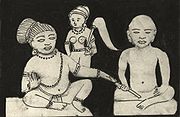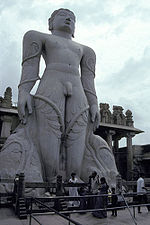
Chavundaraya
Encyclopedia


Talakad
Talakad is a desert-like town on the left bank of the Kaveri river at a spot where the river makes a sharp bend. It is 45 km from Mysore and 133 km from Bangalore in Karnataka, India. A historic site, Talakad once had over 30 temples that today are buried in sand. Now it is a scenic...
(in present day Karnataka
Karnataka
Karnataka , the land of the Kannadigas, is a state in South West India. It was created on 1 November 1956, with the passing of the States Reorganisation Act and this day is annually celebrated as Karnataka Rajyotsava...
, India). A person of many talents, in 982 he commissioned the Gomateshwara, a monolith
Monolith
A monolith is a geological feature such as a mountain, consisting of a single massive stone or rock, or a single piece of rock placed as, or within, a monument...
ic sculpture in Shravanabelagola
Shravanabelagola
Shravana Belgola is a city located in the Hassan district in the Indian state of Karnataka and is 158 km from Bangalore. The statue of Gommateshvara Bahubali at Śravaṇa Beḷgoḷa is one of the most important pilgrimage destinations in Jainism, one that reached a peak in architectural and sculptural...
, an important place of pilgrimage for Jains. He was a devotee of the Jain Acharya Nemichandra
Nemichandra
Nemichandra Siddhanta Chakravarty , was the celebrated author of Dravyasamgraha, Gomattasara , Triloksara, Labdhisara and Kshapanasara. He was among the most distinguished of the Jain Acharyas....
and Ajitasena Bhattaraka and was an influential person during the reign of Kings Marasimha II, Rachamalla IV, and Rachamalla V (Rakkasa Ganga). A courageous commander with the title of Samara Parashurama, he found time to pursue his literary interests as well and became a renowned writer in Kannada and Sanskrit
Sanskrit
Sanskrit , is a historical Indo-Aryan language and the primary liturgical language of Hinduism, Jainism and Buddhism.Buddhism: besides Pali, see Buddhist Hybrid Sanskrit Today, it is listed as one of the 22 scheduled languages of India and is an official language of the state of Uttarakhand...
. He wrote an important and existing prose piece called Chavundaraya Purana (also known as Trishasthi Lakshana Purana) in Kannada (978) and Charitrasara in Sanskrit. In his writing, he claims he was from the Brahmakshatriya Vamsa (Brahmin
Brahmin
Brahmin Brahman, Brahma and Brahmin.Brahman, Brahmin and Brahma have different meanings. Brahman refers to the Supreme Self...
and converted to the Kshatriya
Kshatriya
*For the Bollywood film of the same name see Kshatriya Kshatriya or Kashtriya, meaning warrior, is one of the four varnas in Hinduism...
caste). He patronised the famous Kannada grammarians Gunavarma and Nagavarma I
Nagavarma I
Nagavarma I was a noted Jain writer and poet in the Kannada language in the late 10th century. His two important works, both of which are available are, Karnataka Kadambari, a champu based romance novel and an adaptation of Bana's Sanskrit Kadambari, and Chandombudhi Nagavarma I (c. 990) was...
and the poet Ranna
Ranna
Ranna was one of the earliest poets of Kannada language.Ranna, Adikavi Pampa and Sri Ponna together are called "three gems of Kannada literature".-Early days:Ranna was born on 949 C.E. in Muduvolalu Bagalkot district, Karnataka....
whose writing Parusharama Charite may have been a eulogy of his patron. Because of his many lasting contributions, Chavundaraya is an important figure in the history of medieval Karnataka.
Commander

Khottiga Amoghavarsha
Khottiga Amoghavarsha was a ruler of the Rashtrakuta Empire. During this period the Rashtrakutas started to decline. The Paramara King Siyaka II plundered Manyakheta and Khottiga died fighting them. This fact is available from the Jain writing Mahapurana written by Pushpadanta. He was succeeded...
. In fact, the Gangas supported the cause of the Rashtrakutas till the very end. During the last years of Rashtrakuta rule, the Gangas were also under constant threat of civil war and from invasions of the increasingly powerful Chola Dynasty
Chola Dynasty
The Chola dynasty was a Tamil dynasty which was one of the longest-ruling in some parts of southern India. The earliest datable references to this Tamil dynasty are in inscriptions from the 3rd century BC left by Asoka, of Maurya Empire; the dynasty continued to govern over varying territory until...
. When a civil war broke out in 975, Chavundaraya supported the cause of Prince Rachamalla IV and installed him on the throne.
An inscriptional eulogy of Chavundaraya on the Tyagada Brahmadeva pillar at Shravanabelagola (which has beautiful engravings representing Chavundaraya and his guru Nemichandra at the base) praises him thus,
The 10th century Algodu inscription of the Mysore district
Mysore district
Mysore District is an administrative district located in the southern part of the state of Karnataka, India. The district is bounded by Mandya district to the northeast, Chamrajanagar district to the southeast, Kerala state to the south, Kodagu district to the west, and Hassan district to the north...
and the Arani
Arani
Arani or Aarani may refer to:* Arani, Hindu, goddess of female sexuality and fire.* Arani, Bolivia, a city in Bolivia* Arani Municipality, a municipality in Bolivia* Arani Province, a province in Bolivia...
inscription from the Mandya district provide more information on the family genealogy of Chavundaraya. It states that Chavundaraya was the grandson of Govindamayya who is praised for his knowledge and Dharma
Dharma
Dharma means Law or Natural Law and is a concept of central importance in Indian philosophy and religion. In the context of Hinduism, it refers to one's personal obligations, calling and duties, and a Hindu's dharma is affected by the person's age, caste, class, occupation, and gender...
and was the son of Mabalayya, a subordinate of King Marasimha II. Mabalayya and his brother Isarayya are praised for their prowess in the inscription. It is believed that their political position under King Marasimha II may have led to a gradual adoption of Kshatriya
Kshatriya
*For the Bollywood film of the same name see Kshatriya Kshatriya or Kashtriya, meaning warrior, is one of the four varnas in Hinduism...
status by this Brahmin family.
Writings

Jinasena
Jinasena is the name of several famous Jain Acharyas of the Digambar tradition.* The author of Harivamsha Purana in the 8th century. He belonged to the Punnata branch of Jain monks....
and Gunabhadra
Gunabhadra
Gunabhadra was a monk of Mahayana Buddhism from Magadha, India. He travelled to China by sea with Gunavarma in 435. They were both treated as honored guests by Emperor Wen, the ruler of South China at the time. In China, he translated one of the key texts of Mahayana Buddhism, the Lankavatara...
during the rule of Rashtrakuta Amoghavarsha I. The prose work, composed in lucid Kannada, was meant mainly for the common man and avoided any reference to complicated elements of Jain doctrines and philosophy. In his writing, the influences of his predecessor Adikavi Pampa
Adikavi Pampa
Pampa , called by the honorific Ādikavi is one of the greatest Kannada poets of all time.He is very famous even today for his philosophical beliefs...
and contemporary Ranna are seen. The writing narrates the legends of twenty-four Jain Tirthankaras, twelve Chakravartis, nine Balabhadras , nine Narayanas and nine Pratinarayanas – narrations on sixty-three Jain proponents in all.
Builder
The Gomateshwara monolith, a statue of the Jain saint, Gomateshwara, was commissioned by Chavundaraya and built on the Indragiri hill (also known as Vindhyagiri HillVindhyagiri Hill
Vindyagiri is one of the two hills in Shravanabelagola in the Indian state of Karnataka. The other one being Chandragiri.-History:The Large Hill is first referred to as "Per kavappu" in 8th Century, but its history begins with that of Gommateshwara in the Late 10th century...
) is a unique example of Western Ganga sculpture. Carved from fine-grained white granite, the image stands on a lotus. It has no support up to the thighs and is 60 feet tall with the face measuring 6.5 feet. With the serene expression on the face of the image, its curled hair with graceful locks, its proportional anatomy, the monolith size, and the combination of its artistry and craftsmanship have led it to be called the mightiest achievement in sculptural art in medieval Karnataka. It is the largest monolithic statue in the world. The Chavundaraya basadi
Basadi
Basadi is a Jain shrine or temple.The word is generally used in South India, including Maharashtra. Its historical use in North is preserved in the names of the Vimala Vasahi and Luna Vasahi temples of Mount Abu...
also in Shravanabelagola and built on the Chandragiri Hill
Chandragiri Hill
Chandragiri is one of the two hills in Shravanabelagola in the Indian state of Karnataka, the other one being Vindhyagiri.-History:The recorded history surrounding the hill started in 300 BC when Shruthakevali, Bhadrabahu and Chandragupta Maurya visited the place in order to attain religious peace...
is credited to him by some scholars while others argue it was built by his son Jinadevana. However by the 12th century additions to the shrine were made by a later King Gangaraja by which time tradition held that the shrine was built by Chavundaraya. However another view holds that the original shrine itself was consecrated in the 11th century and built in memory of Chavundaraya.
External links
- Chamundaraya and Shrvanabelagola
- Jaina Minsiter Chavundaraya by K. L. Kamat

